Key takeaways:
- Embracing chaos as an opportunity for personal growth can lead to clarity and adaptability in challenging situations.
- Identifying personal triggers—such as internal uncertainty and multitasking—enables proactive management of chaos and fosters a more focused approach to tasks.
- Regularly evaluating and adjusting strategies is essential for maintaining productivity, promoting flexibility, and finding harmony amidst chaos.
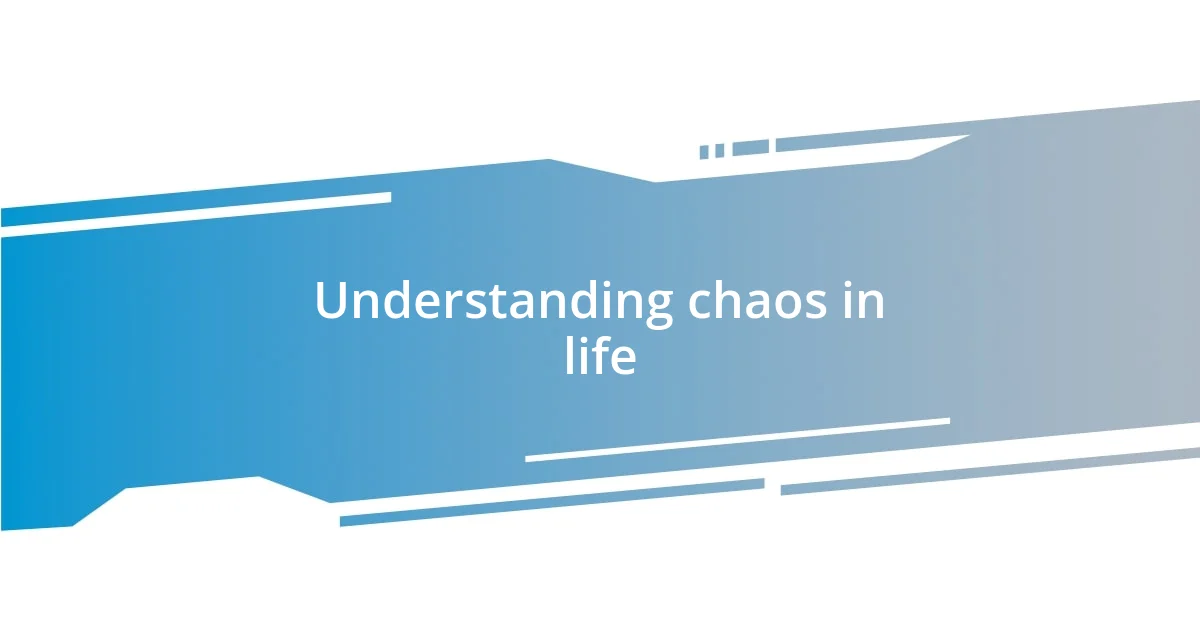
Understanding chaos in life
Chaos in life often feels like an unpredictable storm. I remember a time when my daily routine unraveled due to unforeseen circumstances—like when my car broke down on the way to an important meeting. It struck me how quickly plans can change and how one minor event can ripple out, disrupting everything.
Reflecting on chaos, I often think about how it forces us to adapt. Have you ever experienced a situation where everything that could go wrong did? I certainly have, and during those turbulent times, I found myself gaining clarity about what truly matters. Embracing uncertainty became a survival tactic for me, shifting my focus from the chaos to the opportunities that lie within it.
When I look at chaos through this lens, it becomes less intimidating. It’s like dancing to a tune that keeps changing—challenging, yes, but also a chance to discover new steps. Sometimes, I remind myself that even in the wildest moments, I can choose how to respond, turning chaos into a personal growth experience.
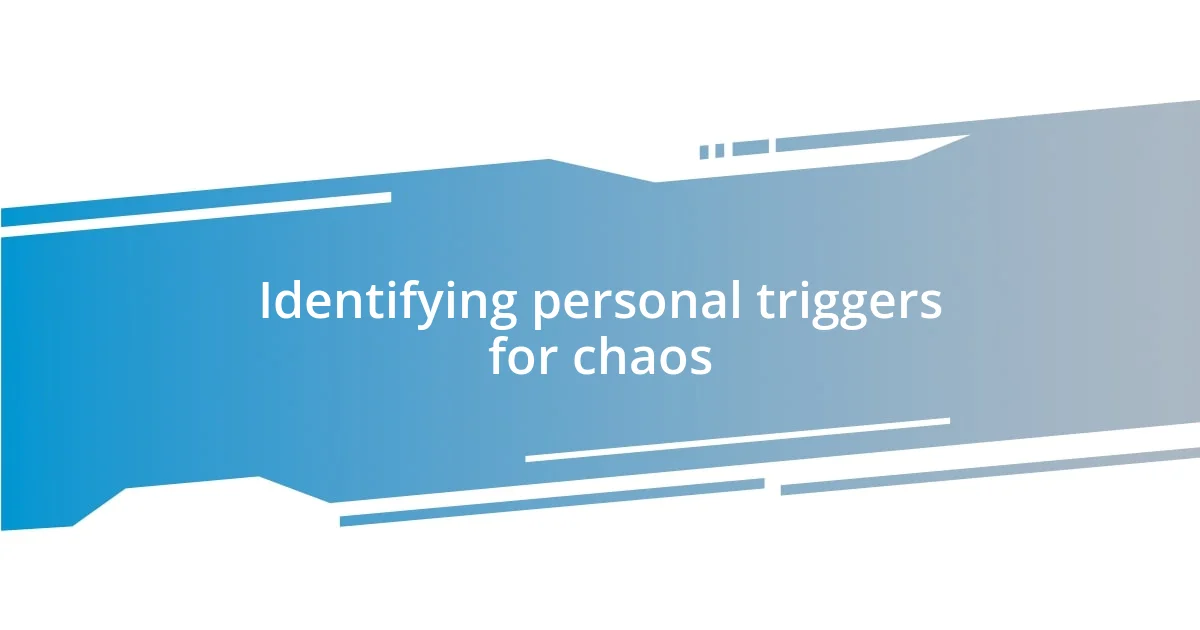
Identifying personal triggers for chaos
Identifying personal triggers for chaos is a crucial step in managing it. For instance, I’ve noticed that my internal chaos often spikes during times of uncertainty, like job transitions or personal relationship shifts. Each time I’ve faced a significant life change, it felt like standing on shaky ground. I learned that by recognizing these feelings early and pinpointing the exact triggers, I could create strategies to mitigate the fallout before it escalated.
Another personal trigger for chaos I’ve identified is multitasking. I remember juggling multiple projects at work, feeling accomplished at first. However, that sensation quickly morphed into a mess of missed deadlines and forgotten commitments. Understanding that my brain thrives on focused tasks rather than spreading myself thin allowed me to recalibrate my approach. Now, when I feel that familiar tingle of overwhelm, I extract myself from the whirlwind and prioritize one task at a time. It’s a simple yet powerful shift that brings clarity to the chaos.
Additionally, external influences can also trigger personal chaos. For example, I’ve found that spending time in overly stimulating environments can leave me feeling drained and irritable. Being surrounded by constant noise or interruptions makes it difficult to concentrate or maintain a sense of calm. Identifying this trigger helped me establish boundaries around my work and personal time, leading to a more serene environment where I can thrive.
| Trigger Type | Personal Experience |
|---|---|
| Internal Uncertainty | Job transitions led to heightened anxiety; recognizing the trigger allowed me to prepare and adapt better. |
| Multitasking | Initially felt productive but ended in chaos; now I focus on one task at a time for clarity. |
| External Environment | Overstimulation from noise drains my energy; I now set boundaries for a calmer workspace. |
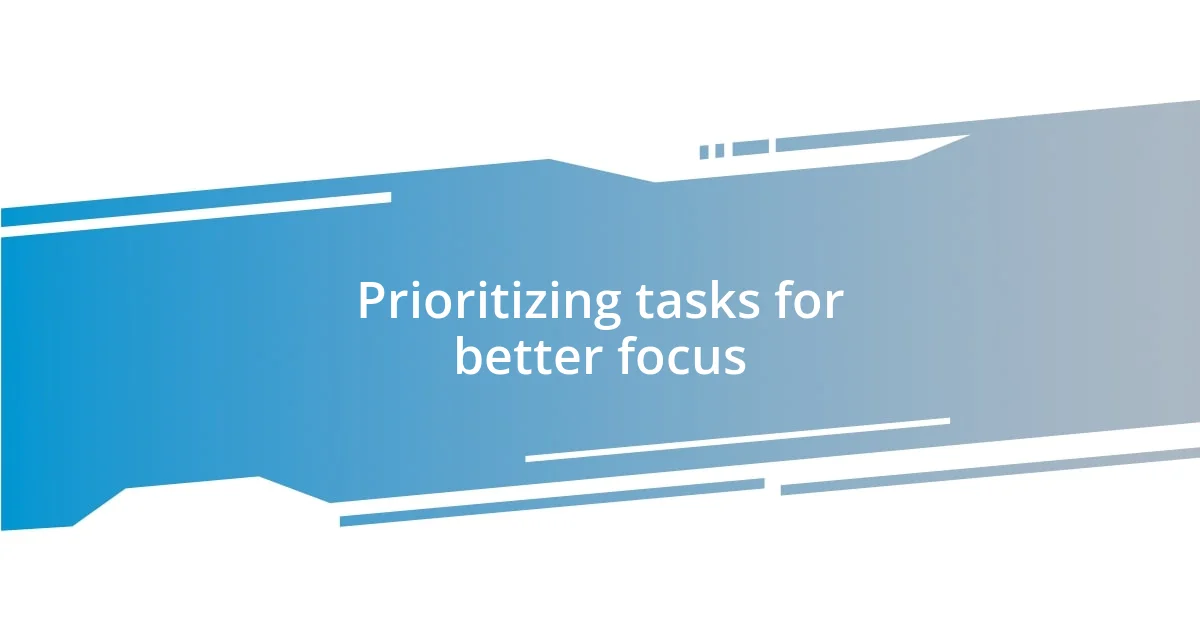
Prioritizing tasks for better focus
When I think about prioritizing tasks, it reminds me of a time when I felt completely overwhelmed with responsibilities. I remember standing in front of my to-do list, feeling paralyzed by the sheer volume of tasks. I realized then that not all tasks hold the same weight. By identifying what truly mattered in that moment—project deadlines versus minor errands—I found a way to simplify my approach. This shift allowed me to focus my energy where it counted, leading to better results and, surprisingly, less stress.
Here are some practical strategies I use for prioritizing tasks:
-
Identify Urgency vs. Importance: I often use the Eisenhower Matrix to differentiate between what’s urgent and what’s important. This helps me tackle pressing issues without neglecting long-term goals.
-
Set Clear Objectives: Each morning, I jot down three key tasks that align with my broader goals. Committing to completing these gives my day structure and purpose.
-
Break Tasks into Smaller Steps: It’s easy to get intimidated by big projects. By breaking them down into bite-sized pieces, I feel a sense of accomplishment with each completed step, which motivates me to keep going.
-
Limit Distractions: When I focus on a task, I eliminate distractions—like my phone or noisy environments. This not only enhances my concentration but also speeds up my work.
-
Reflect and Adjust: At the end of the day, I reflect on what I’ve accomplished. This introspection helps me adjust my strategy for the next day, reinforcing an ongoing cycle of improvement and focus.
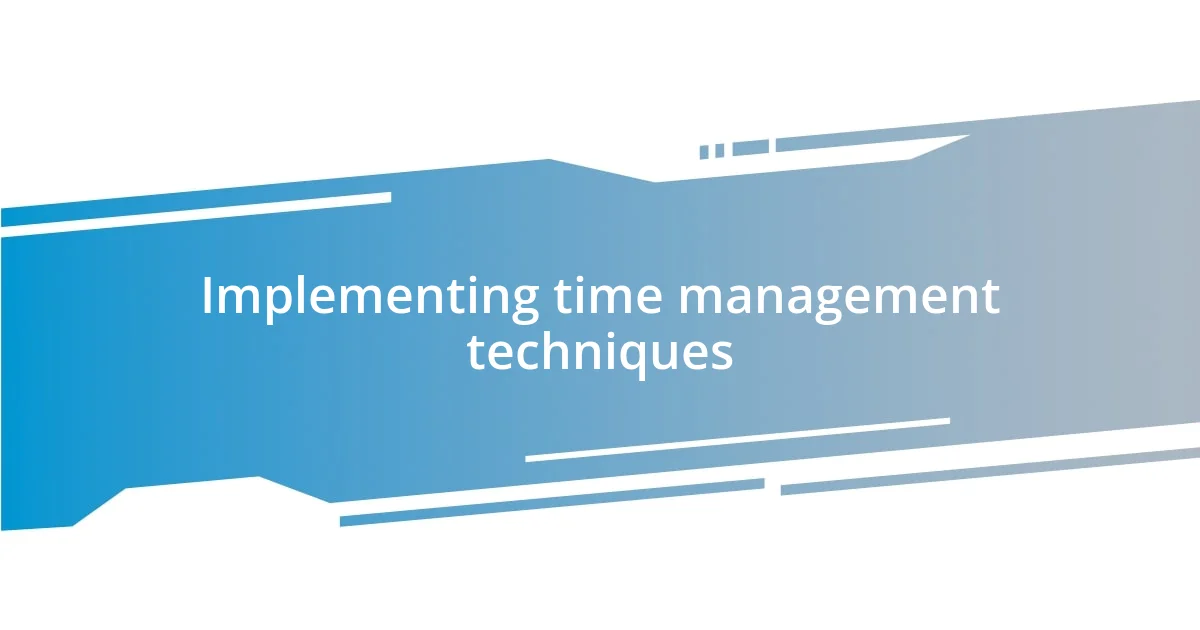
Implementing time management techniques
Implementing time management techniques has truly transformed my ability to handle chaos. One technique that I frequently rely on is the Pomodoro Technique. I find that breaking my work into 25-minute intervals, followed by a 5-minute break, rejuvenates my focus. There was a particularly chaotic week when deadlines loomed, and I needed to maintain clarity. Embracing this method not only made work feel more manageable but also provided a sense of rhythm to my day. Have you ever tried it? It’s amazing how a simple timer can create pockets of productivity amidst the storm.
Beyond structured intervals, I also embrace digital tools to keep my life organized. For example, I’ve turned to apps like Trello and Todoist, which help me visualize tasks and deadlines. In one chaotic phase of life, where I was balancing freelance projects and personal commitments, I found myself forgetting important tasks. By laying everything out in a clear format, I felt empowered to tackle my day with confidence instead of dread. Just seeing everything in one place allows me to breathe a little easier. It’s like having a map in a chaotic landscape; it directs my steps.
In my experience, something as simple as a daily planner can work wonders. Every evening, I take a few moments to jot down my priorities for the next day. It’s in these quiet moments of planning that I often uncover insights about what truly matters. I remember a time when I felt overwhelmed, and simply writing down my thoughts allowed me to unpack the complexities cluttering my mind. When I wake up with a predefined plan, it not only makes my mornings smoother but also shifts my mindset from chaos to purpose. Do you think a little planning could change your approach, too? It’s about finding what resonates best for you.
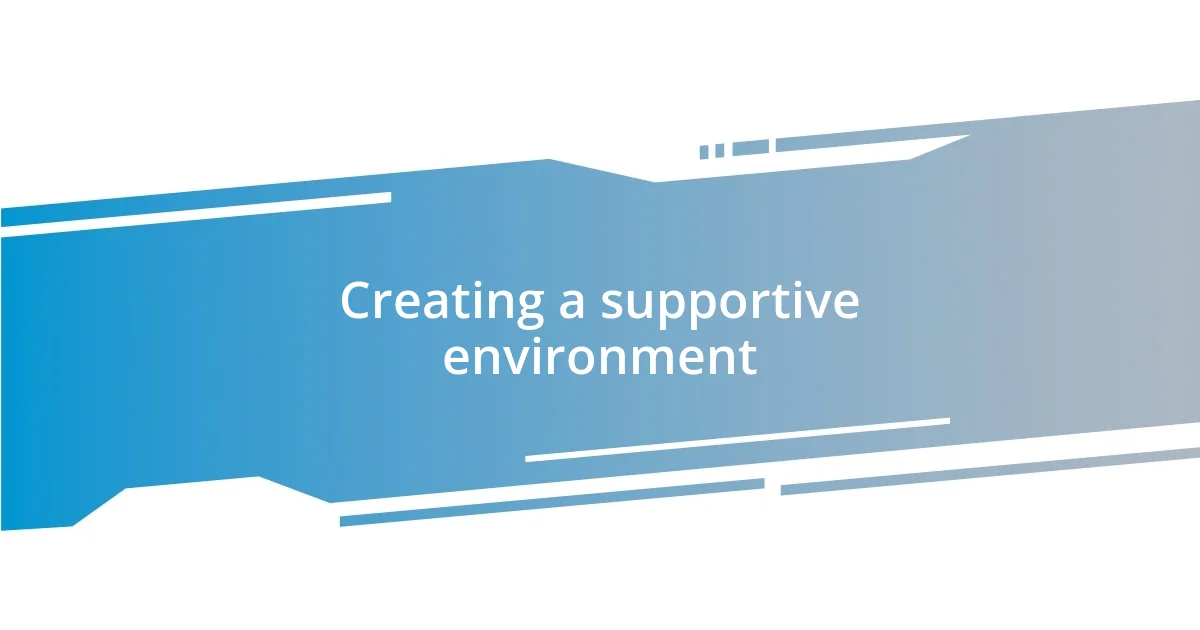
Creating a supportive environment
Creating a supportive environment is crucial when managing chaos in our lives. I recall a time when I worked from a cluttered desk that mirrored the chaos I felt inside. Once I finally cleared my workspace and added personal touches—like plants and motivational quotes—I noticed a significant shift in my mood and productivity. Have you thought about how your surroundings might impact your mental state? I find that a tidy, inspiring space can provide the mental clarity needed to tackle challenges head-on.
Support also extends to the people we surround ourselves with. I’ve made it a point to foster relationships with those who uplift me, especially during stressful periods. When I was facing a particularly heavy workload, a colleague reminded me to take a breather and share my thoughts. That simple conversation not only eased my pressure but also opened up new perspectives on problem-solving. Do you have go-to people who can offer support during chaotic times? Knowing someone has your back can make navigating through storms a lot more manageable.
Lastly, I’ve learned that self-compassion is a vital part of creating a supportive environment, especially during chaotic times. There were moments when I was overly hard on myself for not meeting my own high expectations. Embracing the idea that it’s okay to be imperfect has been a game changer. Instead of viewing setbacks as failures, I now see them as opportunities for learning and growth. How do you treat yourself when things go awry? I’ve found that showing myself kindness not only nurtures resilience but also fosters a more welcoming atmosphere for creativity and progress.
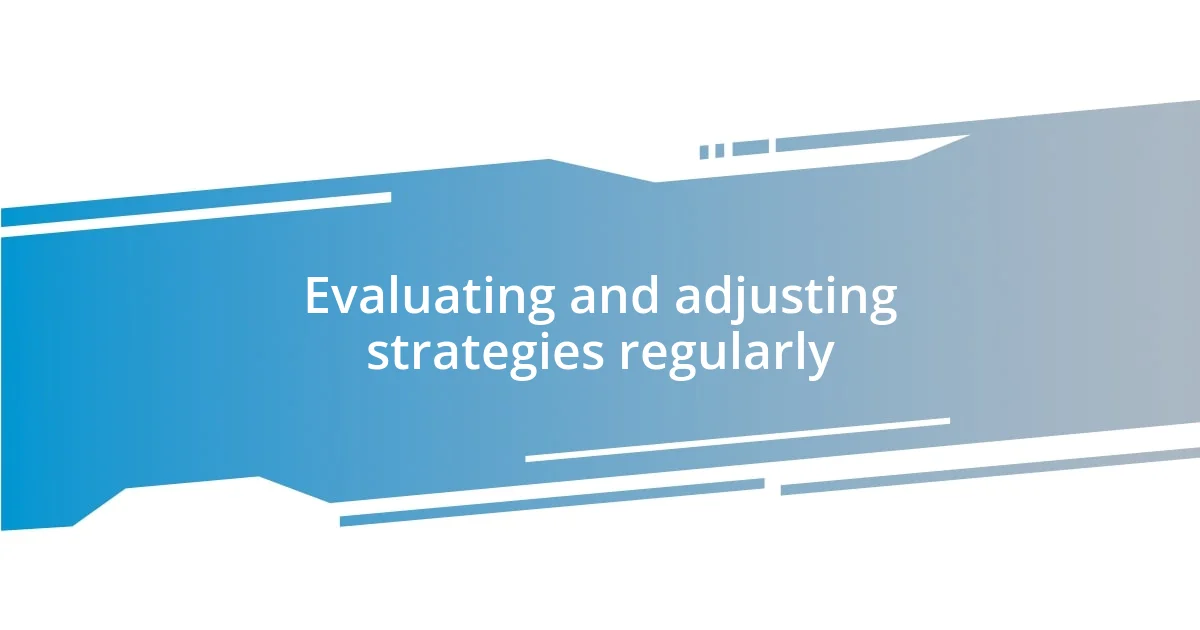
Evaluating and adjusting strategies regularly
Evaluating and adjusting strategies regularly feels like an ongoing conversation I have with myself about what’s working and what’s not. There was a time when I rigidly followed my initial game plan without questioning its effectiveness. After experiencing a steep decline in my productivity, I realized that regularly checking in on my strategies allowed me to identify bottlenecks and areas ripe for improvement. Can you relate to that moment when you realized the plan wasn’t cutting it anymore?
In practice, I’ve found that keeping a simple journal helps me reflect on my daily routines and outcomes. Each week, I jot down what worked well and what left me feeling overwhelmed. There’s this fascinating clarity that comes when you put pen to paper. One of those weeks, I noticed that my late-night work sessions were draining my energy significantly. By pivoting my schedule to earlier in the day, I surprisingly reclaimed hours for myself. Have you ever tracked your progress only to uncover a surprising pattern?
Adjusting strategies isn’t just about tweaking what you do; it’s also about embracing a mindset of flexibility. I often remind myself that chaos is a constant, and our strategies should evolve with it. For instance, during a particularly busy period, I embraced batching similar tasks together instead of reacting to them as they came. That shift not only saved me time but also gave me a sense of control. Do you feel a sense of freedom in flexibility? The key is to keep evolving, and I genuinely believe that regular evaluation is an essential part of finding harmony amid the chaos.













